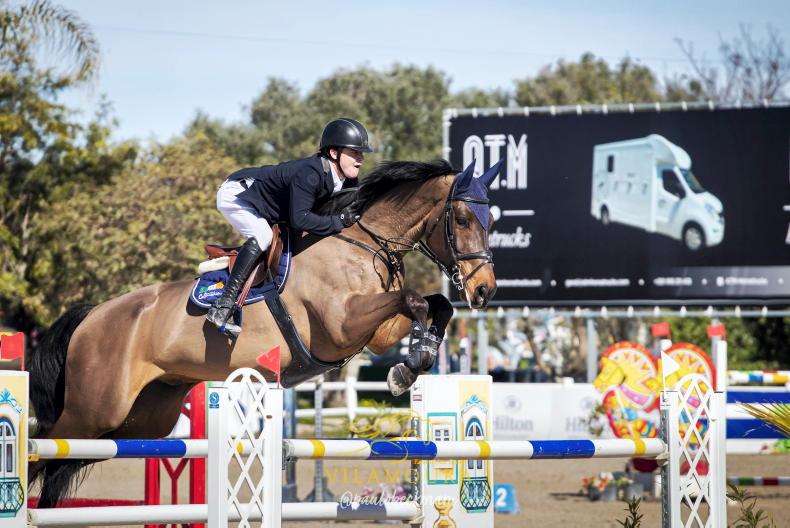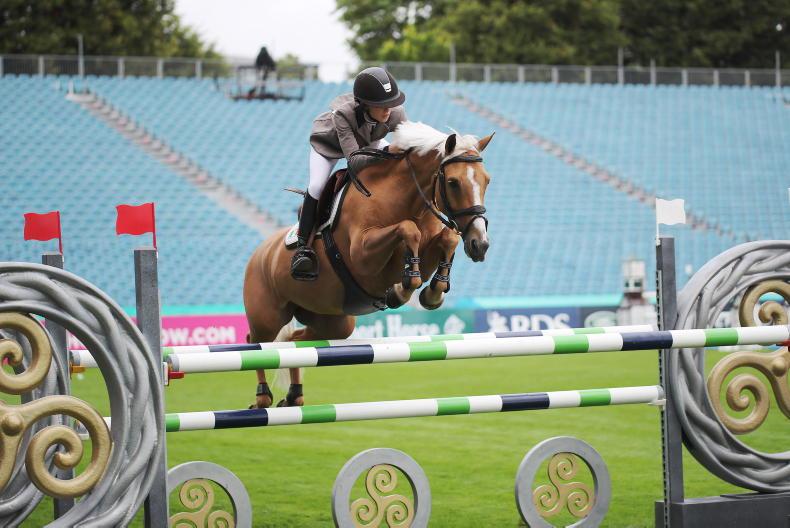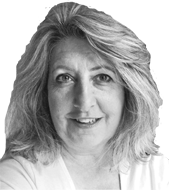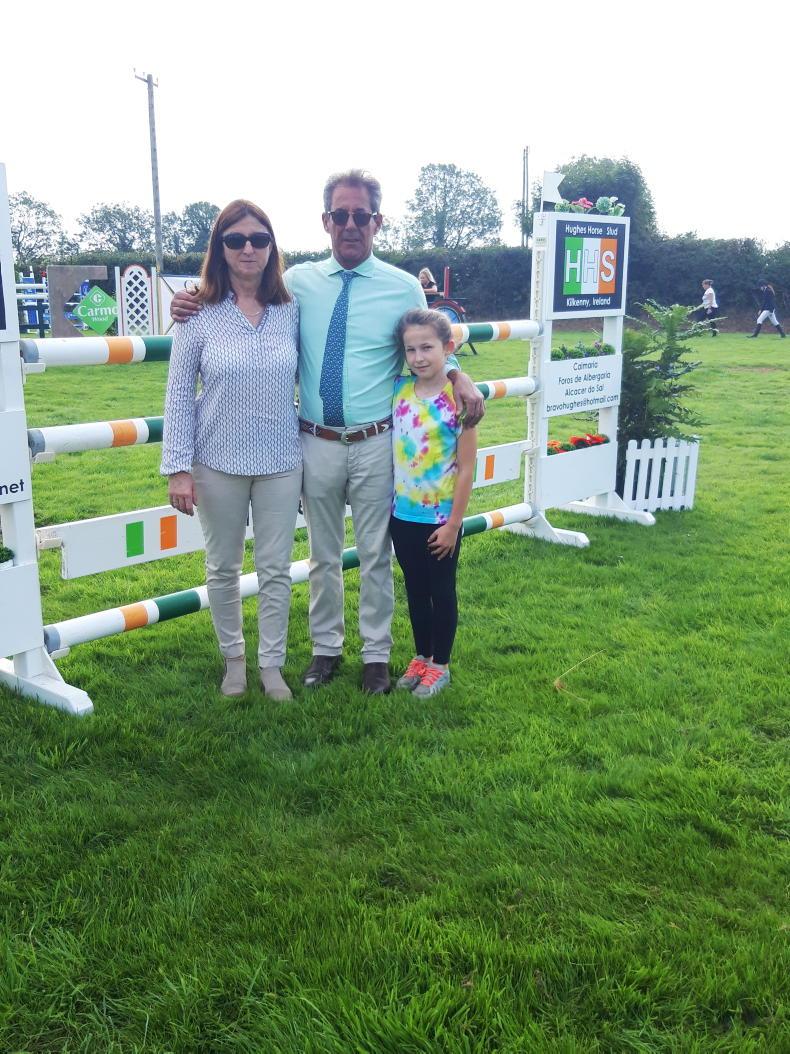RIGHT ON cue, HHS Fast Forward and Mikey Pender win a 1.50m class at Vilamoura. It’s the perfect send-off for bright young talent Pender, competing this week and next at the Doha leg of the Global Champions Tour with HHS Calais (Cavalier Royale) and HHS Catwalk (Cit Cat).
“Fast Forward (Fortunus) is a really smashing horse. He wouldn’t have as much experience as Calais, Catwalk and Burnchurch, they’re the main three for Mikey but Fast Forward is catching up,” his breeder-owner Marion Hughes had predicted last week.
“There’s also a nice mare called Los Angeles (Le Roi 10), a half-sister to Burnchurch and Fast Forward, she’d be my best young horse. She’s in Portugal at the moment. During Covid, we did some embryos so she missed out a little bit and has to catch up, but looks a lovely mare.”
The HHS team is thousands of miles apart this weekend with Marion in America while husband Miguel Bravo and stable jockey Pender are in Qatar. “We’re lucky enough that Mikey has quite a nice team and that we’re doing the Globals again this year on Athina Onassis’s team. It’s a big privilege for us to be asked to be part of that team.”
From scores of horses listed on Marion’s SJI record, MHS Going Global – the horse sold to Onassis in 2016 after his Rio Olympics appearance with Greg Broderick – appears amongst them. Just for one show but he made an impression on Marion who had spotted the youngster out at grass at her cousin Tom Brennan’s base in May and offered to get the Quidam Junior gelding match-fit.
“He was a young, really soft horse, he’d jumped in Dublin the year before. They take six weeks to start them off and get them up to a level, most horses would be in from January or February, so I did that for Tom and I rode Going Global at one [Dublin] qualifier.
Any inkling then of his Olympic potential? “He was a strong character! He could easily leave you on the floor in the first five or 10 minutes when you rode him but then he was fine. I suppose you need that strength of character and athleticism in a horse. He looked like a good horse but he was only turning the corner, then he went to Greg’s and Greg took him over and he loved him, it was an amazing combination. That made his life.
“We’re all looking for a Going Global, Athena Onassis is still looking for another one too! I spoke to her about him and they love that horse, he’s the perfect horse.”
‘The perfect horse’ was bred by Tom’s mother Ita. Both she and niece Marion are constant features of the World Breeding Federation for Sport Horses (WBFSH) and Hippomundo breeder rankings. Cavalier Royale frequently appears in both the Mill House Stud (MHS) and Hughes Horse Stud (HHS) bloodlines. And Heritage Fortunus.
“He gave me his heart,” she says about the Hanoverian stallion and her Athens Olympics horse. “It was amazing to be there. You’d love to change things that happened in your round but at least you can’t take away that you were there. It’s very hard at times in the sport.
“Billy Twomey had gone well the whole time with Luidam and then at the last minute the horse got injured which was such a shame, because the likes of Billy Twomey, he’s an Olympic rider all day,” she says giving another example of how the best-laid plans can go astray in the Olympic run-up.
“To get a horse to the Olympics, stay sound and to be in the frame that you can get picked for the team is hard. If I hadn’t gotten in to Rome, I wouldn’t have got to the next show and the next show. Sometimes you need a little bit of luck.”
Great asset
Unsurprisingly, she’s yet another not in favour of the three-member team format introduced for equestrian sports at the Olympic Games.
“I don’t like it all. It’s too tough on the horses and we have to look after our horses. We’re talking about horses here. A relay team? That’s fine, there’s no horses involved. But for such big animals, you never know what slight thing can go wrong. They can be 100% two hours before and then all of a sudden, you have a problem and you can’t play with your fourth rider.
“With the fourth man, even if your horse couldn’t jump that morning, at least your team is there. Also, I think for the sport going forward, the more people that can compete in the Olympics, the better.
“That fourth rider place gives that extra chance for a young person. If there’s only three riders, it’s very hard for a young, up-and-coming rider to break into those three spaces, whereas with the fourth rider, there was more of a chance to get on the team and show yourself off.
“Take Heidi Robbiani [Hauri] with Jessica,” she remarked about how the Games played out in favour of Robbiani, who won an individual bronze medal at Los Angeles.
Mikey Pender is one young rider who has already broken into the top end of the rankings.
“We’re so lucky to have him as part of the team. We saw his talent from a long time ago, he’s a great man, a great brain. He loves his horses, he’s completely dedicated and this is what he wants in his life - show jumping.
“Mikey wants to be number one in the world and we’re delighted that we’re helping him to get on his way. He’s 39th in the world which is fab, considering he hasn’t done a major championship.”
And he’s based in Ireland? “Completely. He has his own yard of horses at home and some really exciting prospects coming along which is brilliant for him and for his family too.
“Otherwise, he might never be in Ireland [if he took a job abroad]. He might be home for one day at Christmas but instead, he’s still very involved with Ireland which is brilliant and it’s a great asset to Ireland to have him. It’s fine when they go off to America, for example, but then they’re gone forever.”

Mikey Pender and Marion Hughes' home-bred gelding HHS Calais \ Vilamoura
Are faraway hills greener? “You see the sunny days but you don’t always see the work involved. Darragh Kenny starts at 5am in the morning working the horses so they’re perfect for his clients,” she replies, giving an example of the equally long hours and high expectations of the American scene.
The extra red tape and paperwork that Brexit and Covid have added to the logistics of shuttling from mainland Europe. “We’ve been using the long boat [from France], although the older horses don’t come home, unless it’s for embryos or a two month rest. Otherwise we have to rent a base in Europe.”
“Miguel always stays on the road with Mikey, I’m with the girls and I pop in and out. That’s what it is. Covid was bad but in one way, it was good as it got us off the rollercoaster for a little while.
“For the world rankings points, I think you should have to pick 42 weeks of the year to compete for points, instead of 52. Then you get a chance to say, ‘Okay, I’m not going to ride in January’, so you can have a life.
“Just freeze the months because, at the moment, if you don’t get points for a month, you drop down the rankings. For the likes of Mikey, it’s fine because he’s young but for people with families, it would be great if they had the choice to could freeze some points to have some quality of life.”
All the dots
Family life with their daughters – Molly, Marta and Matilde – is the number one priority for Marion and Miguel and already the trio are following their parents’ path. At last year’s Dublin championships, Marta won the Horse Sport Ireland (HSI) 148cms final with the distinctive palomino HHS Mustang Sally, by Annaghmore Boomerang.
That appaloosa stallion brought three of the McSorley children – Seamus, Joanne and Brendan – to Dublin as their proud aunt points out. Marion’s sister Ann Marie and her husband Brendan McSorley also owned Clover Echo, a stallion that features in HHS bloodlines.

Marta Hughes Bravo and HHS Mustang Sally, winners of the 148 National Championship at the RDS last summer \ Laurence dunne Jumpinaction.net
Another cousin Seamus Hughes Kennedy, whose mother Clare competed Flo Jo at Dublin as a novice, is another of this next generation to shine, having won a gold medal at the WBFSH seven-year-old final at Lanaken in 2019 with Cuffesgrange Cavadora.
That Dublin arena, where Mikey won last year’s Flexible five-year-old championships with HHS Tokyo (Z Seven Ascot), is the one Marion rates as the scene of her most memorable highlights.
“I suppose the two Aga Khans on home ground. That’s one good thing about being Irish, with a lot of the international competitions abroad, you don’t get the same kick out of competing with the home crowd behind you. With Charlton, I had a double clear and we were second, that was in 1999. And then with Fortunus, the year we went to the Olympics, I was on the winning team. That was unbelievable.
“In Europe, show jumping is a huge sport but now in Ireland, racing is a bigger sport. You’re more of a hero in racing world than show jumping. It was different years ago when Eddie Macken was a hero but times have changed a lot with more communications – you can watch any sport on television now – and more for people to do.
“That’s the sport now and that’s something we all have to remember: show jumping is a sport. Sometimes, it’s so business and money-orientated nowadays that people can forget it is a sport.
“The problem is it takes so much money nowadays to be involved in it. It’s just to get all the dots together. You need good horses, you can be as good a rider as you want but it you don’t have a good horse, you’re never going to get anywhere.”
Good horses have already been bred in Cuffesgrange where right hand man Brendan Doyle is in charge of the breeding stock. Part of the team since before Marion and Fortunus’ Olympic year, he is keenly aware of breeding trends. “He’s got his ear to the ground about the successful stallions.”
How many foals do they breed each year? “Around 20 foals, including embryos. We try to keep it mixed when picking stallions, not just all the young popular sires. You look at the auctions, fancy sires making fancy money, it’s commercial nowadays breeding horses. You have to throw a lot of money at it, buying frozen semen, vets fees are expensive. It can be difficult to justify it all,” she says candidly.
Have a say
She is just as frank about her reasons for taking up her role on Horse Sport Ireland’s Breeding and Production Advisory Council (BPAC).
“For years, you hear people giving out about ‘HSI this, HSI that’, blaming people for stuff, so when Alison Corbally said ‘We need people with some knowledge of the sport and breeding to work with us, to get some ideas and try to improve it.’ I said ‘okay.’
“Nobody has time. Everybody is busy so I just thought it’s the right thing to do, to try and give something back, to use the bit of knowledge that I have picked up from Europe and around Ireland, and from producing your own horses in Ireland, to help and get involved.
“I must say Alison [Corbally] was fantastic and she’s worked hard with the Department of Agriculture for years to build up the funding. I think Alison and Nadia [Rea] have done a wonderful job at developing all the schemes and Horse Board series. At least it helps people to pay their way at the shows.
“If you look at the racing industry, it’s the money from the Government that pays most of the prize money for racing and that keeps the trainers going, keeps the owners going, that what keeps the sport going.
“So at least by putting the money back into the sport and Irish-bred horses, it does encourage people to breed Irish horses and it does stop them maybe from going to Europe to buy the best three-year-old. Keep looking in Ireland.”
Does she think the breeding scene has improved in Ireland? “People in Ireland have tried a lot harder now to produce better horses. Isn’t it great that Going Global was produced here? By a foreign stallion but with Irish bloodlines, so it’s a mixture, but you’re still going back to those old bloodlines. I think breeders are definitely trying.
“BPAC was very disappointed actually that Alison Corbally left, because we worked with her a lot and found her fantastic really,” Marion says, commenting on the recent departure by the HSI Director of Breeding and Programmes.
“It’s a shame because like us, she has 20 years’ experience. She worked in Necarne, she knows the sport, she knows the Department, and she’s done a lot for the sport. She hasn’t done it for herself and been very involved with the breeders. She’s a good connection between the sport and HSI as the governing body.
“Same with Nadia, if ever I had a problem, ring Nadia, they’ll set you right. I’m sure there’s other fantastic girls in there now as well. With Covid, we haven’t been able to meet them [in person] but still, we all like to know who we’re talking to at the other end of the phone.”
Another addition is Irish Horse Board chairman and Mayo businessman, Tiernan Gill. “He started last year. We needed new blood, we needed new people, new energy and he’s brilliant, I love having him on board,” added Marion who thinks that show jumpers such as Greg Broderick and Ger O’Neill would also bring something to the Horse Board and BPAC tables.
“I think BPAC is very important going forward, because BPAC is representative of all the people in Ireland. I still would encourage people to go forward for the Irish Horse Board because we need young blood, we need young, enthusiastic people to put their name forward because it’s through the Horse Board that our names were put forward for BPAC.
“There should be new people coming through on the Horse Board that can move up to BPAC that can get involved and have a say in the sport. It would be terrible if we took the sport away from the breeders, if the breeders and horsey people of Ireland didn’t have a say.”


 This is a subscriber-only article
This is a subscriber-only article
 It looks like you're browsing in private mode
It looks like you're browsing in private mode












SHARING OPTIONS: